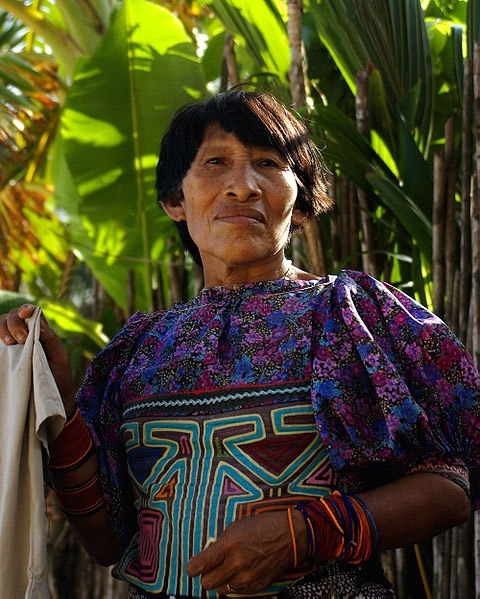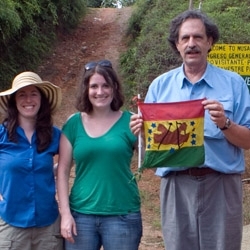The United Nations is evaluating the human rights record of Panama this spring with some help from MIT Professor of Anthropology James Howe and the graduate students in his new course, “Monitoring the Rights of Native Peoples." Howe and his students have submitted a five-page report for the Universal Periodic Review (UPR), the United Nations’ process for reviewing human rights practices around the world.
Of the process, Dorota Chapko, a sophomore in brain and cognitive sciences, says, "One of the greatest things about this class is that we are shaping a report that can have a positive impact for the indigenous people in Panama. The feeling of coming to class for an actual, direct cause is amazing.”
Indigenous people of Panama
“The big issues we wrote about are the land grabs, the impact of tourism and dams,” said Howe, who has studied the Kuna (the best-known of Panama’s native peoples) for more than 40 years. “Kuna have a very strong belief that land was given to them by Great Father. They want to control it.”
Lands belonging to the Kuna and other native peoples in Panama are rich in natural resources, which means outsiders continually seek to exploit them for ranching, tourism, mining and even hydroelectric projects, Howe said.
“When indigenous interests clash with those of miners, dam-builders or peasant colonists, then anti-Indian sentiment and stereotypes ... break through the thin crust of tolerance and acceptance in Panamanian public discourse,” Howe writes in his latest book, Chiefs, Scribes, & Enthnographers: Kuna Culture from Inside and Out (November 2009, University of Texas Press).
The impact
“The hope is that if enough of these reports go in (to the UPR), it may exert pressure on the Panamanian government,” Howe said. Although the UN’s recommendations are not enforceable, states prefer to avoid the embarrassment of a poor report. As Howe notes, “Countries don’t want to be on record violating international agreements.”
Officially, the report has been submitted by Cultural Survival, a nongovernmental organization that advocates for the rights of indigenous peoples around the world. Howe, who serves on the organization’s board, said he got the idea of producing the report as a class project from Professor Lawrence Susskind of the Department of Urban Studies and Planning.
Fact-finding trip to Panama
In addition to siftting through paperwork, three students got the chance to accompany Howe on a fact-finding trip to Panama. “The opportunity to go abroad and meet first-hand with the indigenous peoples in Panama, as well as meet with the NGOs specializing in human rights issues there, was absolutely essential for an informed perspective in writing the UPR report,” said Karina Lundahl, a graduate student in the Science, Technology, and Society Program. “It's wonderful that the anthropology section chose to support the work.”
Visit from a Kuna anthropologist
Another highlight of the class was a visit from Bernal Castillo, a professional anthropologist and historian who is himself a Kuna. Castillo spent several days at MIT, made a presentation to the class and shared his research materials with Howe and his students in support of the UN project. Howe pointed out that in so doing, Castillo joins a long line of Kuna who have actively worked to shape the view outsiders have of their people — a topic Howe explores in depth in Chiefs, Scribes, & Enthnographers.
“Not everyone in anthropology works with indigenous people anymore. But those who do have to do it in a collaborative way,” he said. “Human rights is part of the same thing. It’s something that we owe them back.”
Of the process, Dorota Chapko, a sophomore in brain and cognitive sciences, says, "One of the greatest things about this class is that we are shaping a report that can have a positive impact for the indigenous people in Panama. The feeling of coming to class for an actual, direct cause is amazing.”
Indigenous people of Panama
“The big issues we wrote about are the land grabs, the impact of tourism and dams,” said Howe, who has studied the Kuna (the best-known of Panama’s native peoples) for more than 40 years. “Kuna have a very strong belief that land was given to them by Great Father. They want to control it.”
Lands belonging to the Kuna and other native peoples in Panama are rich in natural resources, which means outsiders continually seek to exploit them for ranching, tourism, mining and even hydroelectric projects, Howe said.
“When indigenous interests clash with those of miners, dam-builders or peasant colonists, then anti-Indian sentiment and stereotypes ... break through the thin crust of tolerance and acceptance in Panamanian public discourse,” Howe writes in his latest book, Chiefs, Scribes, & Enthnographers: Kuna Culture from Inside and Out (November 2009, University of Texas Press).
The impact
“The hope is that if enough of these reports go in (to the UPR), it may exert pressure on the Panamanian government,” Howe said. Although the UN’s recommendations are not enforceable, states prefer to avoid the embarrassment of a poor report. As Howe notes, “Countries don’t want to be on record violating international agreements.”
Officially, the report has been submitted by Cultural Survival, a nongovernmental organization that advocates for the rights of indigenous peoples around the world. Howe, who serves on the organization’s board, said he got the idea of producing the report as a class project from Professor Lawrence Susskind of the Department of Urban Studies and Planning.
Fact-finding trip to Panama
In addition to siftting through paperwork, three students got the chance to accompany Howe on a fact-finding trip to Panama. “The opportunity to go abroad and meet first-hand with the indigenous peoples in Panama, as well as meet with the NGOs specializing in human rights issues there, was absolutely essential for an informed perspective in writing the UPR report,” said Karina Lundahl, a graduate student in the Science, Technology, and Society Program. “It's wonderful that the anthropology section chose to support the work.”
Visit from a Kuna anthropologist
Another highlight of the class was a visit from Bernal Castillo, a professional anthropologist and historian who is himself a Kuna. Castillo spent several days at MIT, made a presentation to the class and shared his research materials with Howe and his students in support of the UN project. Howe pointed out that in so doing, Castillo joins a long line of Kuna who have actively worked to shape the view outsiders have of their people — a topic Howe explores in depth in Chiefs, Scribes, & Enthnographers.
“Not everyone in anthropology works with indigenous people anymore. But those who do have to do it in a collaborative way,” he said. “Human rights is part of the same thing. It’s something that we owe them back.”






